This is part 3 of my December 2021 tour of the Ruth Bancroft Garden. Click here for part 1 and here for part 2.
⎯⎯⎯⎯⎯⎯⎯⎯⎯
The final post in this series focuses on the large shade structure over bed 6 in the heart of the garden. Originally erected in 1972, it was taken down and rebuilt in 2020. As part of this project, new soil was brought in to rectify drainage issues that had emerged over the years. This post from May 2020 has more details.
In the winter, the entire shade structure is covered with plastic to create a cozy home for plants that are sensitive to cold or wet weather. There's no additional heating, but the difference between the inside and the outside is noticeable.
Let's take a look at some of the plants inside the “tent:”
 |
| Agave titanota (left) and Echeveria 'Lace', an Echeveria gibbiflora hybrid bred for its ruffled leaf margins |
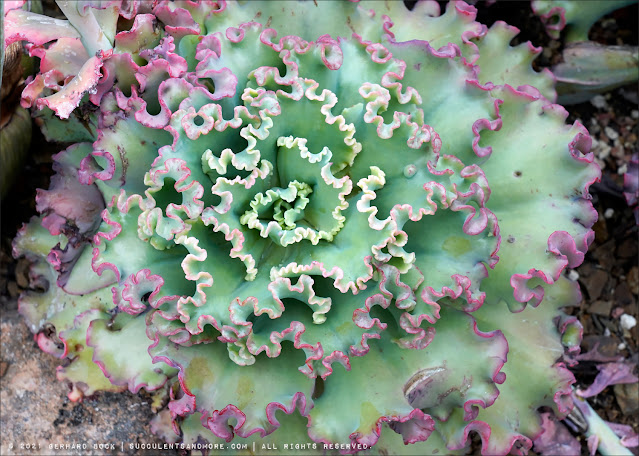 |
| As you can see, every rosette of Echeveria 'Lace'... |
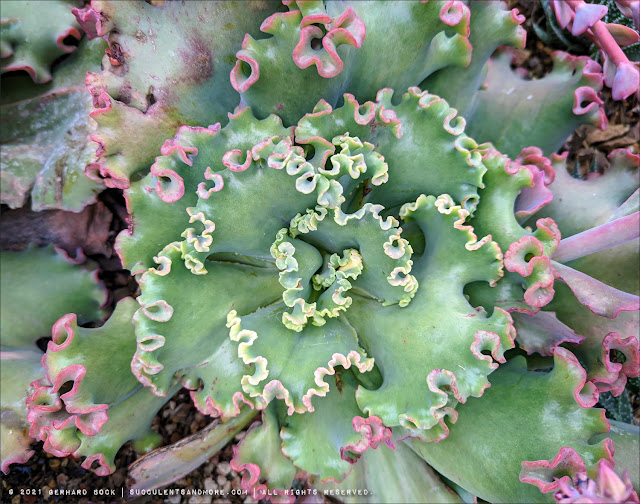 |
| ...is unique |
 |
| Another Echeveria gibbiflora hybrid with pronounced bumps on the leaf surfaces |
 |
| Agave petrophila surrounded by clusters of echeverias |
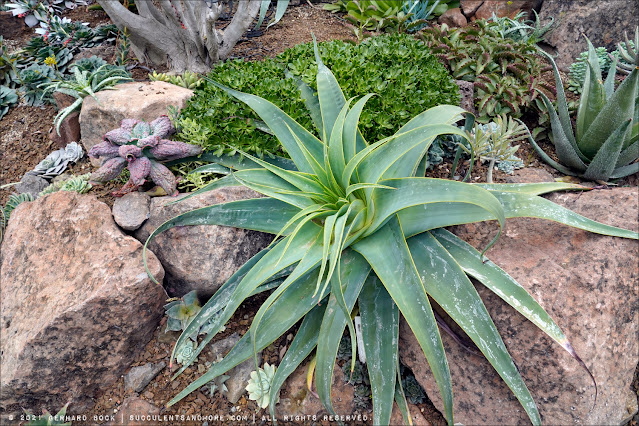 |
| Aloe pulcherrima, a large species from Ethiopia with pliable and nearly toothless leaves |
 |
| In its native habitat, Aloe pulcherrima hangs from steep cliffs. Even in cultivation, the rosette grows at an angle. |
 |
| Aloe 'GW Miller' (Aloe zubb × squarrosa), a neat and compact Brian Kemble hybrid that I wish were available commercially. Here, it's tucked into a crevice between the two rocks and grows almost vertically. |
 |
| Echeveria cante, considered by many to be the most beautiful of all echeverias |
 |
| Pale pink Echeveria cante in front of dark red Echeveria fimbriata (or hybrid) |
 |
| Agave nickelsiae |
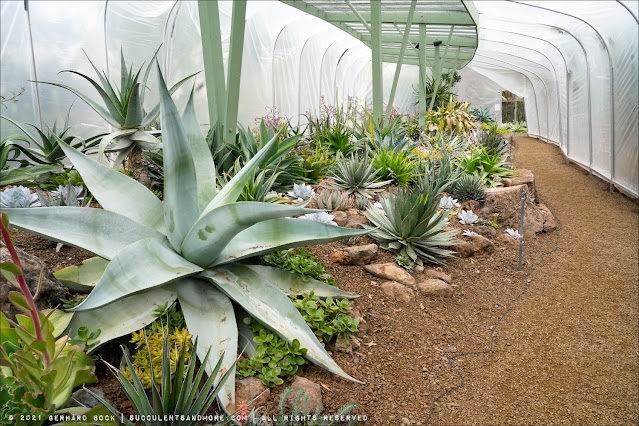 |
| Agave guiengola, the largest agave inside the shade structure |
 |
| Echeveria gigantea with over a dozen flower stalks |
 |
| Impressively toothed Agave horrida |
 |
| Aloe suzannae (two different plants) |
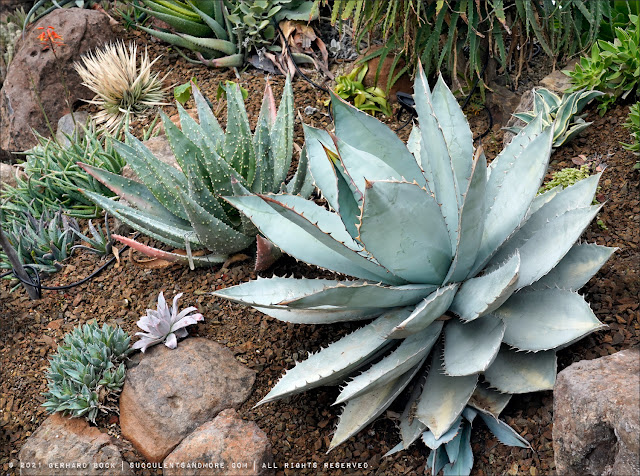 |
| Another Agave titanota |
 |
| Agave 'Blue Glow' with medio-picta variegation |
The photos above only scratch the surface. There are hundreds upon hundreds of other succulents tucked in between the many rocks that were brought in as part of the shade structure renovation. You could easily spend an hour or two exploring the plants growing in bed 6!
After I was done in the garden, I walked through the nursery—always a pleasure since it's so well-stocked. They had just received a delivery of pristine
Yucca rostrata with two to three feet of trunk. This is a slow-growing species and it takes year to develop a trunk. As a result, they aren't cheap, ranging from $900 to $1000 for the plants in the photos below.
As I was returning to the parking lot, the retaining wall shoring up the bed against the fence caught my eye. It's made of reused chunks of concrete (aka
urbanite), and its nooks and crannies are perfect for plants which naturally grow in near-vertical situations:
 |
| Dudleya caespitosa or similar |
 |
| Dudleya caespitosa from California and Bulbine latifolia from South Africa where it's often found growing on cliffs |
As you can see, the Ruth Bancroft Garden continues to change and evolve. That makes me happy because there's always something new to discover every time I visit.
RELATED POSTS:
© Gerhard Bock, 2021. All rights reserved. To receive all new posts by email, please subscribe here.



















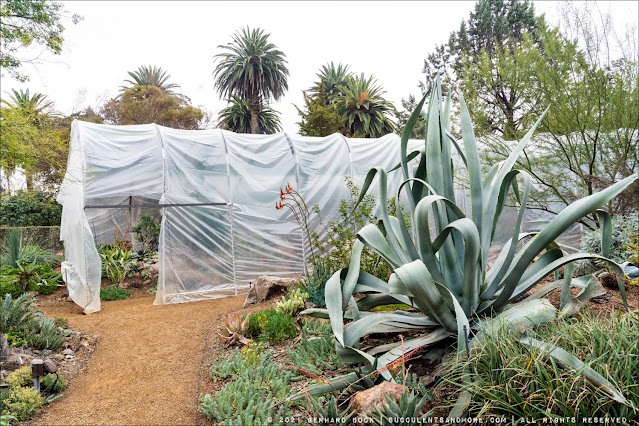


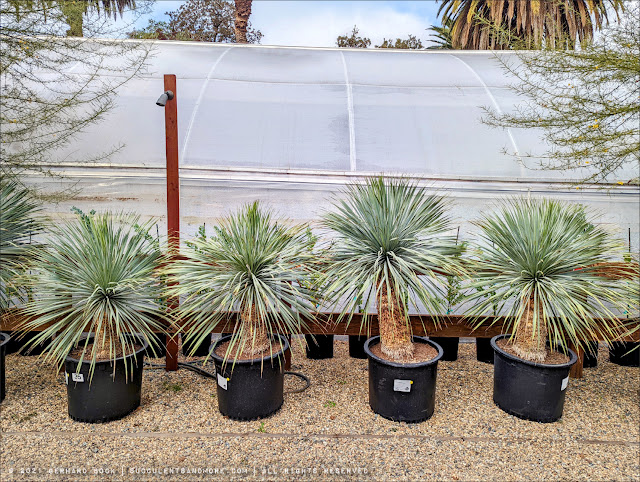
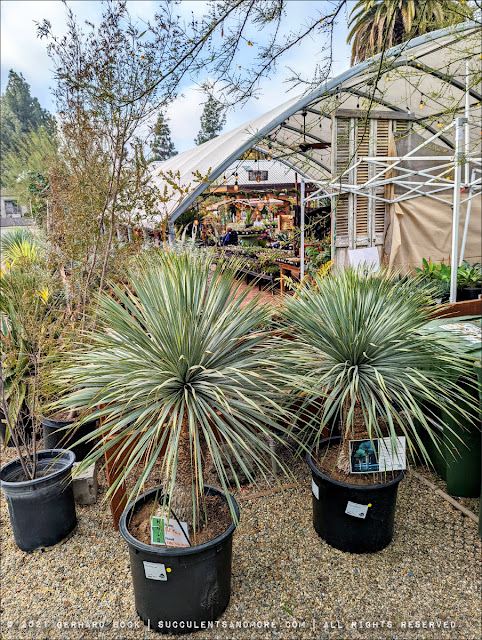
I'm SO impressed with the newly planted area under the tent. It's thoughtfully arranged not only to ensure the health of each specimen but also to show each off in the best way possible. Where is that bullet train when I need it to pay a visit!
ReplyDeleteThe prices on Yucca rostrata you shared have helped me accept my still dinky specimen ;)
I'd take that bullet train from Northern California to Southern California all the time :-)
DeleteI think Yucca rostrata will always fetch high prices because it's such a slow grower--and always in demand.
They sure did a beautiful job replanting (and rebuilding) the shade structure. I'm really looking forward to visiting in January.
ReplyDeleteLet me know if you want to meet up!
DeleteIt would be great to meet up - I'm waiting for rain to reliably taper off . I have a 4 day weekend over New Years so that's my target depending on weather.
DeleteSpecimens in the covered bed look so perfect. I'm always drawn to Agave nickelsiae for it's amazing pattern. Agave horrida looks gorgeous but scary... it would make a wonderful print. You mentioned that bed 6 also gets some summer protection. I wondered how? Do they add temporary slats to the structure?
ReplyDeleteYou didn't say how many Yucca rostrata you picked up on the way out...
Agave nickelsiae is one of my favorites--but why is it so hard to find?
DeleteAgave horrida is actually less scary than it looks. The teeth are not as rigid as you might think.
Yucca rostrata: I passed. I have several specimen in the ground. One is 7-8 ft. tall now. Probably worth $2000 :-)
Thanks for this 3 part series of posts! Living in Phoenix, I have not gotten to the Ruth Bancroft Garden! But I do have The Bold Dry Garden: Lessons from the Ruth Bancroft Garden autographed by Ruth! It's one of my prized possessions!
ReplyDelete